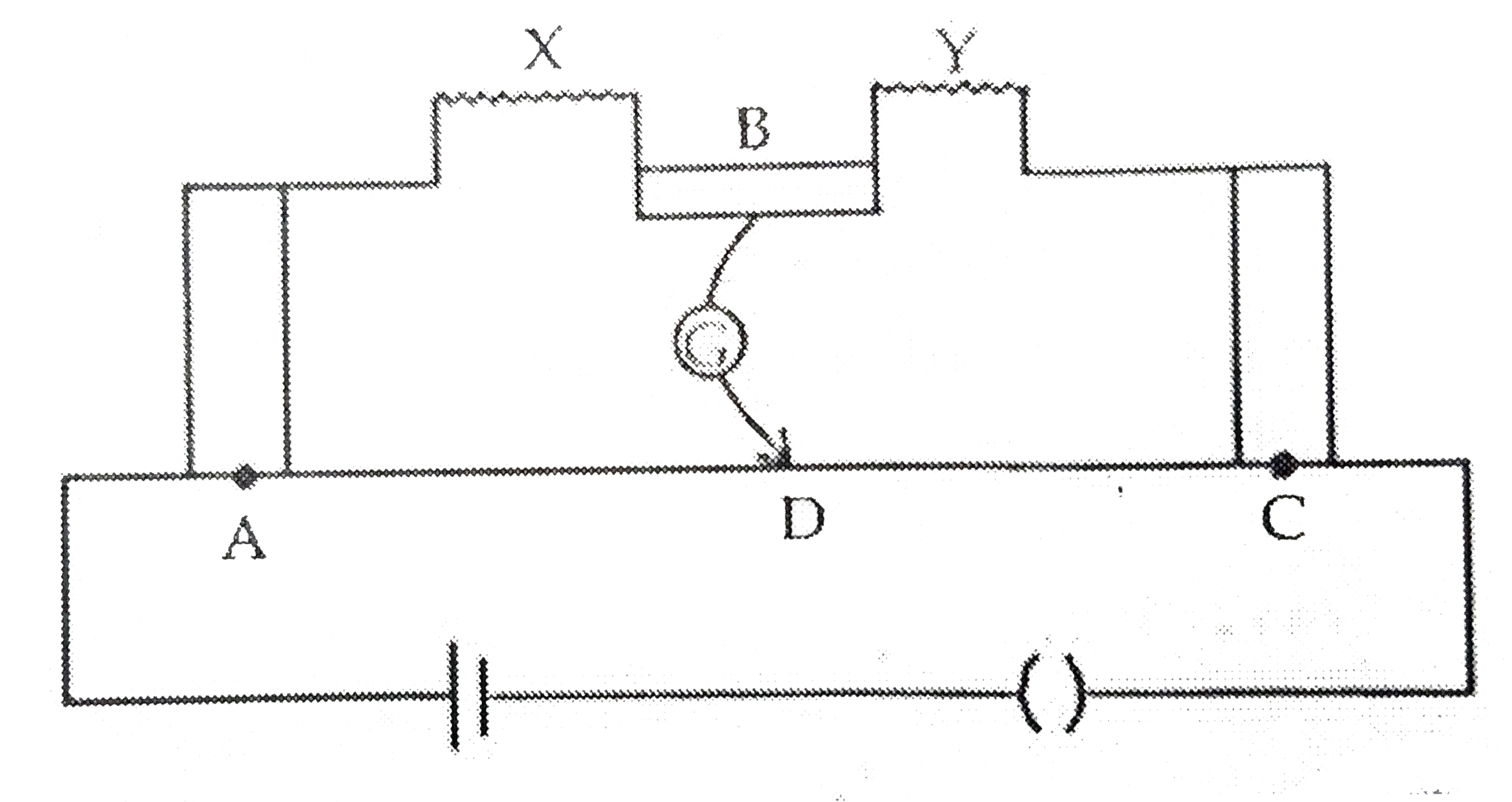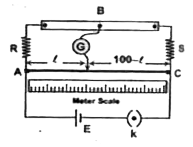Two resistances are connected in two gaps of a meter bridge. The balance point is 20cm from the zero end. A resistance of 15Ω is connected in series with the smaller of the two. The null point shifts to 40cm. The value of the smaller resistance in Ω is
3
6
9
12
The correct Answer is:C
To solve the problem step by step, we will use the principles of a meter bridge and the concept of balancing lengths.
Step 1: Understand the Setup
We have two resistances, R1 (the smaller resistance) and R2 (the larger resistance), connected in a meter bridge. The balance point is initially at 20cm from the zero end.
Step 2: Apply the Balance Condition
Using the meter bridge principle, we can write the balance condition for the first scenario:
R1R2=L1100−L1
Where L1=20cm.
Substituting the values:
R1R2=20100−20=2080=14
This implies:
R2=4R1(Equation 1)
Step 3: Introduce the Additional Resistance
Now, a 15Ω resistance is connected in series with R1. The new resistance R′1 becomes:
R′1=R1+15
And R′2 remains:
R′2=R2=4R1
Step 4: Apply the New Balance Condition
In the second scenario, the balance point shifts to 40cm. We can write the new balance condition:
R′1R′2=L2100−L2
Where L2=40cm.
Substituting the values:
R1+154R1=40100−40=4060=23
Step 5: Cross-Multiply and Simplify
Cross-multiplying gives:
3(R1+15)=2(4R1)
Expanding both sides:
3R1+45=8R1
Step 6: Solve for R1
Rearranging the equation:
45=8R1−3R1
This simplifies to:
45=5R1
Dividing both sides by 5:
R1=9Ω
Conclusion
The value of the smaller resistance R1 is 9Ω.
---
We have two resistances, R1 (the smaller resistance) and R2 (the larger resistance), connected in a meter bridge. The balance point is initially at 20cm from the zero end.
Using the meter bridge principle, we can write the balance condition for the first scenario:
Now, a 15Ω resistance is connected in series with R1. The new resistance R′1 becomes:
In the second scenario, the balance point shifts to 40cm. We can write the new balance condition:
Cross-multiplying gives:
Rearranging the equation:
The value of the smaller resistance R1 is 9Ω.
Topper's Solved these Questions
- CURRENT ELECTRICITYBOOK - DC PANDEY ENGLISHCHAPTER - CURRENT ELECTRICITYEXERCISE - OBJECTIVE_TYPE
1 Videos
- CURRENT ELECTRICITYBOOK - DC PANDEY ENGLISHCHAPTER - CURRENT ELECTRICITYEXERCISE - Level 1 Subjective
53 Videos
- CURRENT ELECTRICITYBOOK - DC PANDEY ENGLISHCHAPTER - CURRENT ELECTRICITYEXERCISE - Level 1 Assertion And Reason
11 Videos
- COMMUNICATION SYSTEMBOOK - DC PANDEY ENGLISHCHAPTER - COMMUNICATION SYSTEMEXERCISE - Subjective
11 Videos
- ELECTROMAGNETIC INDUCTIONBOOK - DC PANDEY ENGLISHCHAPTER - ELECTROMAGNETIC INDUCTIONEXERCISE - Medical entrances gallery
25 Videos
Similar Questions
Two resistances are connected in the two gaps of a meter bridge. The balance point is 20cm from the zero end. When a resistance 15Ω is connected in series with the smaller of two resistance, the null point+ shifts to 40cm. The smaller of the two resistance has the value.
View SolutionTwo resistances are connected in the two gaps of a meter bridge. The balance point is 20cm from the zero end. When a resistance 15Ω is connected in series with the smaller of two resistance, the null point+ shifts to 40cm. The smaller of the two resistance has the value.
View Solution
Knowledge Check
Two resistances are connected in the two gaps of a meter bridge. The balance point is 20cm from the zero end. When a resistance 15Ω is connected in series with the smaller of two resistance, the null point+ shifts to 40cm. The smaller of the two resistance has the value.
A3B6C9D12
Two unknown resistances are connected in two gaps of a meter-bridge. The null point is obtained at 40 cm from left end. A 30Ω resistance is connected in series with the smaller of the two resistances, the null point shifts by 20 cm to the right end. The value of smaller resistance in Ω is
View SolutionWith two resistance R1andR2(>R1) in the two gaps of a metre bridge the balance was found to be 1/3 m from the zero end. When a 6Ωresistance is connected in series with the smaller of the two resistance, the point is shifted to 2/3 m from the same end, then R1andR2 are
View SolutionThe resistance in the left and right gaps of a balanced meter bridge are R1 and R1. The balanced point is 50cm. If a resistance of 24Ω is connected in parallel to R2, the balance point is 70cm. The value of R1 or R2 is.
View SolutionThe figure shows experimental set up of a meter bridge. When the two unknown resistances X and Y are inserted, the null point D is obtained 40 cm from the end A. When a resistance of 10Ω is connected in series with X, the null point shifts by 10 cm. Find the position of the null point when the 10Ω resistance is instead connected in series with resistance 'Y'. Determine the value of the resistance X and Y

View SolutionIn a meter bridge, the null point is found at a distance of 40 cm from A. If now a resistance of 12 Ω is connected in parallel with S, the null point occurs at 60 cm from A. Determine the value of R.

View SolutionIn a metre bridge the null point is found at a distance of 35 cm from A. If now a resistance of 10Ω is connected in parallel with S, the null point occurs at 50 cm. Determine the values of R and S.
View SolutionTwo unkonwn resistances X and Y are connected to left and right gaps of a meter bridge and the balancing point is obtained at 80cm from left. When a 10Ω resistance is connected parallel to X, the balancing point is 50cm from left. The values of X and Y respectively are
View Solution
